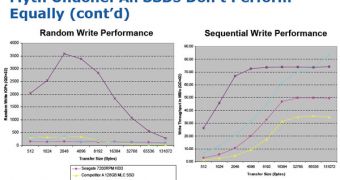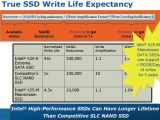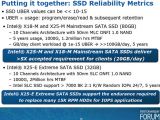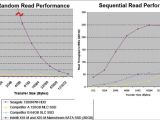It seems that the days of hard disk drives are becoming shorter. The last year brought a lot of news on solid state drives as the future devices to be used for storage. At Intel Developer Forum in San Francisco, the chip manufacturer announced that the era of spinning magnetic platter is coming to an end. The storage market will be soon ruled by the SSDs, which are advertised as offering lower power consumption, faster speeds and longer life. These are the main reasons that will determine customers into buying the new drives, and Intel's engineers presented a lot of numbers that backup their sayings. What they have also said and it is worth noticing is the fact that the performance of any solid state drive is given by its manufacturer.
At IDF, Chris Saleski, an Initiatives Manger at Intel’s Storage Technologies Group, and Jack Weast, Architect with Intel’s Consumer PC Group, presented the next-to-come X18 and X25 mainstream SSDs. The 1.8-inch and 2.5-inch form factor drives will come with storage capacities starting at 80GB and going up to 160GB. In comparison to other drives, Intel's SSDs were said to offer up to five times more speed in some benchmarks. According to the company's representatives, the drives could offer up to 250 megabytes a second transfer rate for sequential reads and a 75 MB/sec write speed.
Al Fazio, another Intel fellow, talked about the longevity of the solid state drives, and said that they actually wear out slower than it was previously believed. According to its presentation, the X-18/25 SSDs feature a MTBF (mean time before failure) rating of 1.2 million hours, about the same as modern server hard drives. Al Fazio said that the drives are able to withstand a workload of 100 GB worth of writes a day for five years.
This may sound like a lot of gigabytes and a lot of time to some, but it may prove not to be enough in other cases. According to Deb Paquin, Intel’s spokesperson for the storage group, only a few gigabytes worth of data are written each day by most people, so it would represent a difficulty to reach 100GB/day. “During onsite tests with our own employees, we found that most people used about 2GB to 3 GB a day, and the highest power user we had was much less than 20GB,” Paquin said. According to what Intel says, any SSD would outlast our bodies, at least at a 2-3 GB a day rate.
When it comes to servers, things may not be so bright at all, and the guys from TG Daily tried to prove it by making simple calculations. The 100 GB/day for five years Intel claims the drive would withstand mean a total of 182.5 terabytes. Assuming that, somehow, the drive would max the transfer rate to 70 MB/sec for its entire life, the 80GB of storage it offers would be filled up in 19 minutes, while the 182.5 terabytes sum would be hit in about 30 days, and that does not sound too good indeed.
The SSDs wear out uniformly, as data is written through the entire drive
According to Paquin, Intel's engineers managed to wear out an SSD, which had quite a “silent” death, unlike hard drives which would fail catastrophically. There is a limited number of writes and erases the flash can withstand, yet modern SSDs spread the writing trough the entire drive. The result is that the drive will wear out uniformly, and the user doesn't even realize it. While some blocks of the drive approach their time, the controller rewrites data and remaps the logical address, which means that the operating system doesn't know any better.
A drive that would be worn out totally becomes read-only, meaning that no data is lost, said Paquin. She also said that long-term storage is not what SSDs are meant for. “No flash SSD should be thought of as an archival storage, but it is important that the drive remain reliable over the serviceable life, which our SATA drive does by the means just described,” she said.
The main reason for the slow adoption of SSDs, even though their specifications place them high above HDDs, is the fact that they are still quite expensive. A 64 GB SSD would get a few hundred dollars out of your pocket for sure. Beside that, some users may somehow “fear” the SSDs. While a hard drive's death can be predicted at any time, an SSD would fail without notice.
As Paquin said, even an SSD's death can be predicted if a SMART technology (Self-Monitoring Analysis and Reporting Technology) was to be used. SMART is constantly monitoring drive blocks and informs on bad sectors, read/write errors and temperature variations. Some say that this technology would allow the OS to predict when a solid state drive wears out, but others argue that things are not always as advertised.
According to John Christopher, a Senior Data Recovery Engineer at DriveSavers, the SMART didn't do as said on the hard drives area and it may just not do as required on the SSDs as well. “S.M.A.R.T. technology showed a lot of promise when it was introduced but hasn't really panned out as a method of providing an early warning system to identify potential hard drive failure,” said Christopher.
He said that SSDs should be implemented with a sort of early warning system, and that it should be present on any type of storage media. “Car makers build systems into vehicles they manufacture that monitor oil levels, brake wear and so forth, so it would make sense to have something similar to future storage devices that we rely on daily to hold critical data,” TG Daily quotes Christopher's sayings, who also added that so far it’s “probably too early to predict how reliable these devices would be in the long term”.

 14 DAY TRIAL //
14 DAY TRIAL // 


